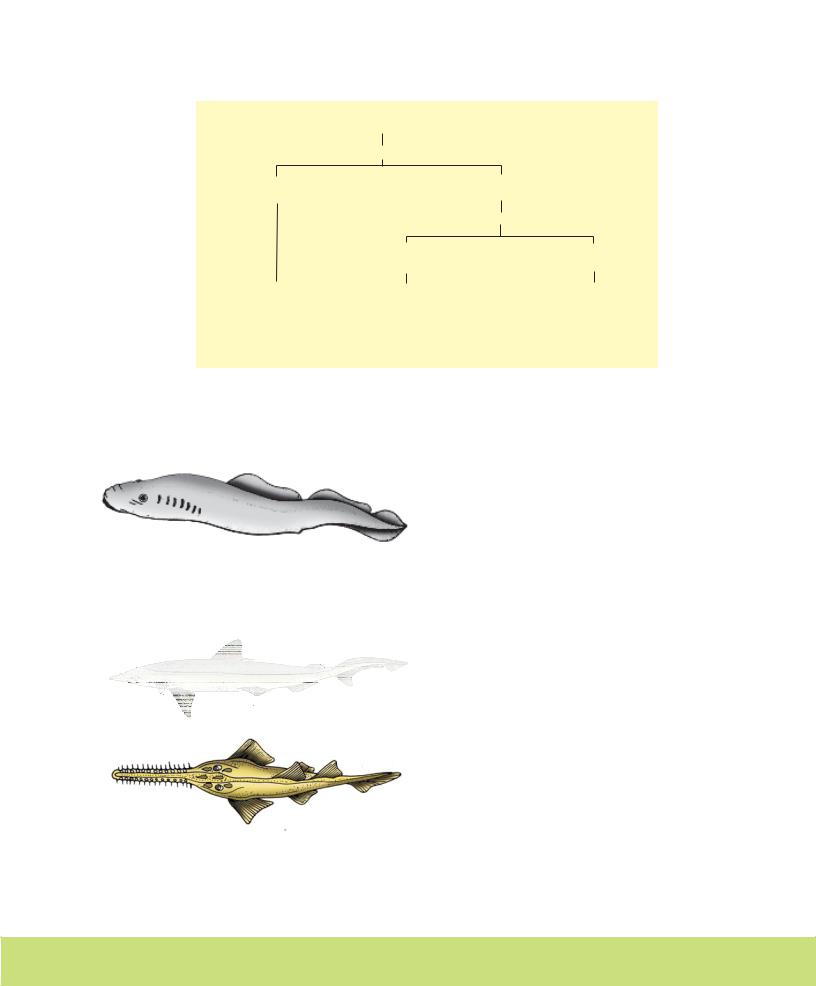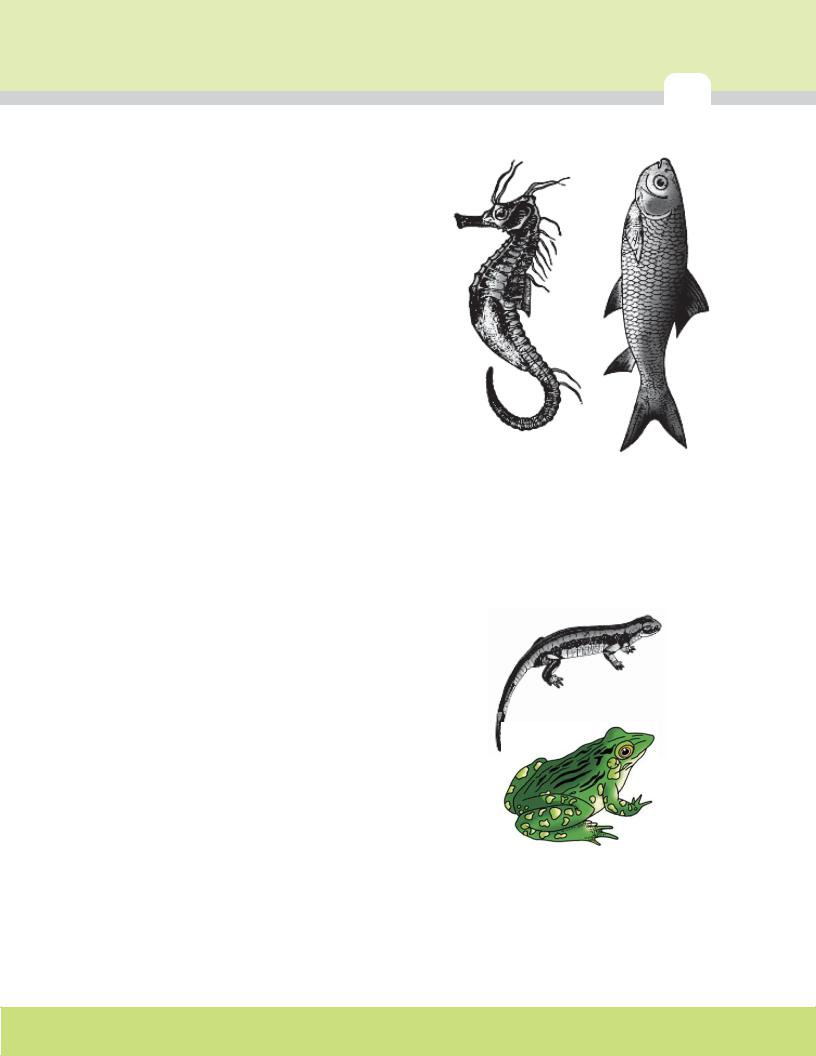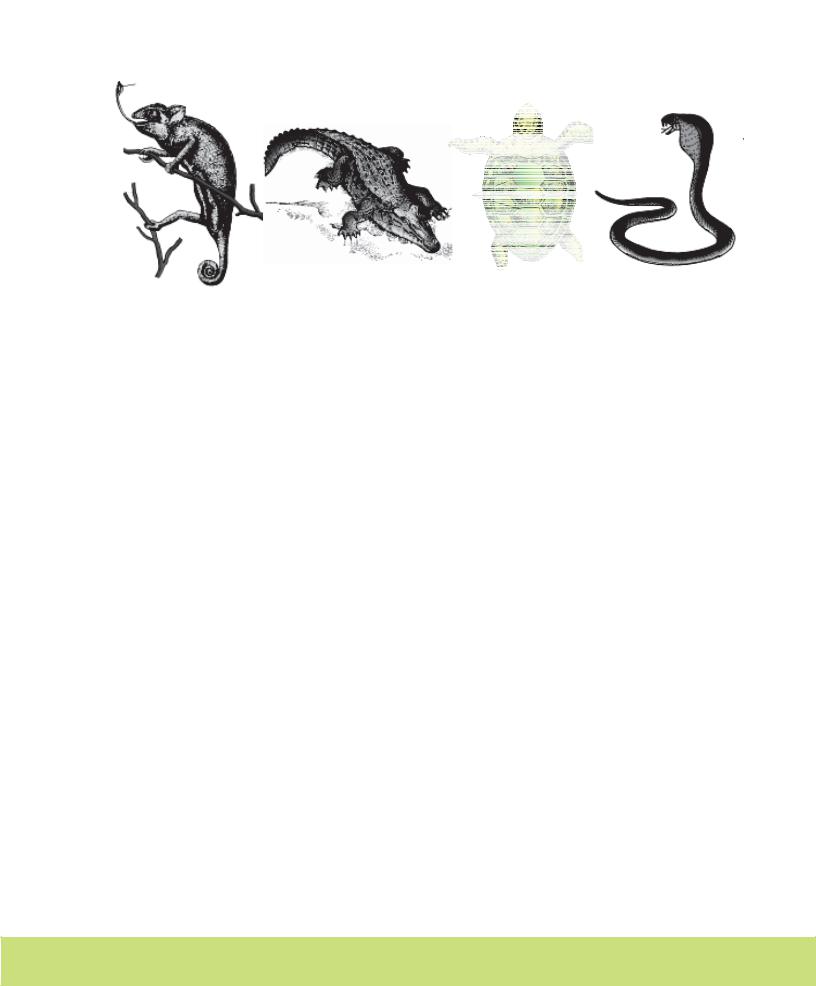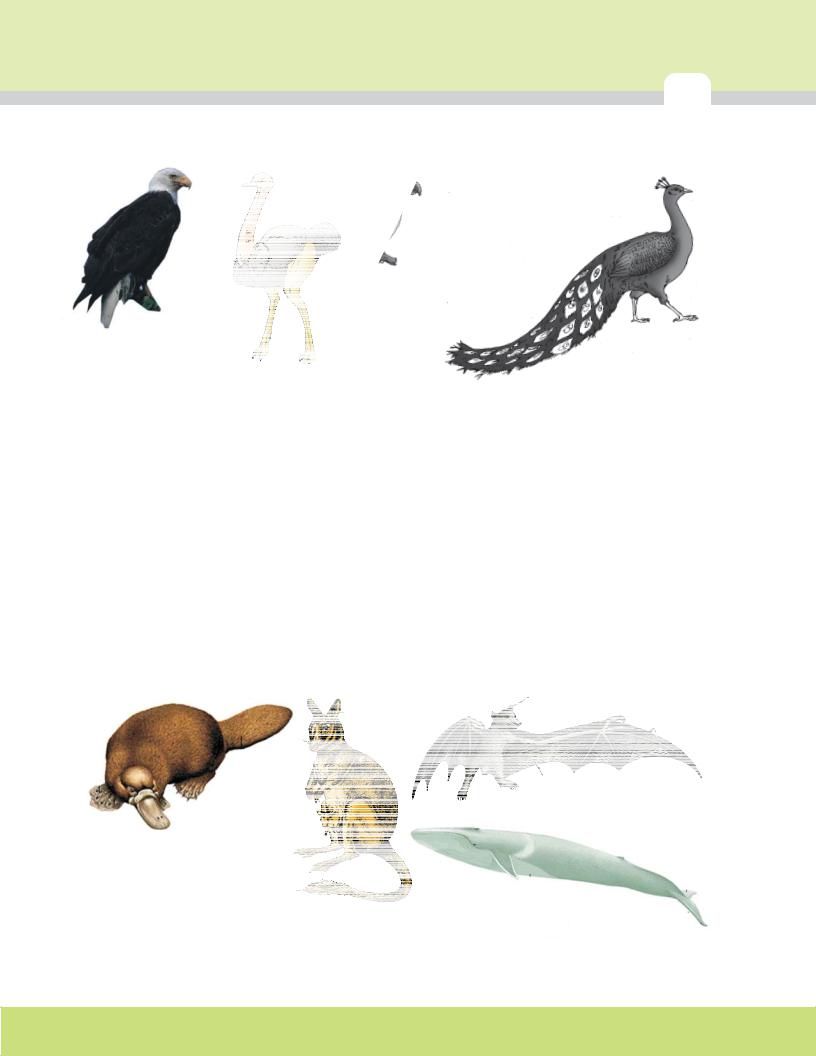
CH 4
.pdf
|
|
56 |
BIOLOGY |
The subphylum Vertebrata is further divided as follows:
Vertebrata
|
Division |
|
|
Agnatha |
Gnathostomata |
|
|
(lacks jaw) |
(bears jaw) |
|
|
|
Super Class |
|
|
|
Pisces |
Tetrapoda |
|
|
(bear fins) |
(bear limbs) |
|
Class |
Class |
|
Class |
1. Cyclostomata |
1. Chondrichthyes |
1. |
Amphibia |
|
2. Osteichthyes |
2. |
Reptilia |
|
|
3. |
Aves |
|
|
4. |
Mammals |
Figure 4.18 A jawless vertebrate - Petromyzon
(a)
(b)
Figure 4.19 Example of Cartilaginous fishes :
(a) Scoliodon (b) Pristis
4.2.11.1Class – Cyclostomata
All living members of the class Cyclostomata are ectoparasites on some fishes. They have an elongated body bearing 6-15 pairs of gill slits for respiration. Cyclostomes have a sucking and circular mouth without jaws (Fig. 4.18). Their body is devoid of scales and paired fins. Cranium and vertebral column are cartilaginous. Circulation is of closed type. Cyclostomes are marine but migrate for spawning to fresh water. After spawning, within a few days, they die. Their larvae, after metamorphosis, return to the ocean.
Examples: Petromyzon (Lamprey) and Myxine (Hagfish).
4.2.11.2Class – Chondrichthyes
They are marine animals with streamlined body and have cartilaginous endoskeleton (Figure 4.19). Mouth is located ventrally. Notochord is persistent throughout life. Gill slits are separate and without operculum (gill cover). The skin is tough, containing minute placoid scales. Teeth are modified placoid scales which are backwardly directed. Their jaws are very powerful. These animals are predaceous. Due to the absence of air bladder, they have to swim constantly to avoid sinking.

ANIMALNIMALKINGDOMKINGDOM
57
Heart is two-chambered (one auricle and one ventricle). Some of them have electric organs (e.g., Torpedo) and some possess poison sting (e.g., Trygon). They are cold-blooded (poikilothermous) animals, i.e., they lack the capacity to regulate their body temperature. Sexes are separate. In males pelvic fins bear claspers. They have internal fertilisation and many of them are viviparous.
Examples: Scoliodon (Dog fish), Pristis (Saw fish), Carcharodon (Great white shark), Trygon (Sting ray).
4.2.11.3Class – Osteichthyes
It includes both marine and fresh water fishes with bony endoskeleton. Their body is streamlined. Mouth is mostly terminal (Figure 4.20). They have four pairs of gills which are covered by an operculum on each side Skin is covered with cycloid/ctenoid scales. Air bladder is present which regulates buoyancy. Heart is twochambered (one auricle and one ventricle). They are cold-blooded animals. Sexes are separate. Fertilisation is usually external. They are mostly oviparous and development is direct.
Examples: Marine – Exocoetus (Flying fish), Hippocampus (Sea horse); Freshwater – Labeo (Rohu), Catla (Katla), Clarias (Magur); Aquarium – Betta (Fighting fish), Pterophyllum (Angel fish).
4.2.11.4Class – Amphibia
As the name indicates (Gr., Amphi : dual, bios, life), amphibians can live in aquatic as well as terrestrial habitats (Figure 4.21). Most of them have two pairs of limbs. Body is divisible into head and trunk. Tail may be present in some. The amphibian skin is moist (without scales). The eyes have eyelids. A tympanum represents the ear. Alimentary canal, urinary and reproductive tracts open into a common chamber called cloaca which opens to the exterior. Respiration is by gills, lungs and through skin. The heart is threechambered (two auricles and one ventricle). These are cold-blooded animals. Sexes are separate. Fertilisation is external. They are oviparous and development is direct or indirect.
Examples: Bufo (Toad), Rana (Frog), Hyla (Tree frog), Salamandra (Salamander), Ichthyophis (Limbless amphibia).
(a) |
(b) |
Figure 4.20 Examples of Bony fishes :
(a) Hippocampus (b) Catla
(a)
(b)
Figure 4.21 Examples of Amphibia :
(a)Salamandra
(b)Rana

|
|
58 |
BIOLOGY |
(a) |
(b) |
(c) |
(d) |
Figure 4.22 Reptiles : (a) Chameleon (b) Crocodilus (c) Chelone (d) Naja
4.2.11.5Class – Reptilia
The class name refers to their creeping or crawling mode of locomotion (Latin, repere or reptum, to creep or crawl). They are mostly terrestrial animals and their body is covered by dry and cornified skin, epidermal scales or scutes (Fig. 4.22). They do not have external ear openings. Tympanum represents ear. Limbs, when present, are two pairs. Heart is usually three-chambered, but four-chambered in crocodiles. Reptiles are poikilotherms. Snakes and lizards shed their scales as skin cast. Sexes are separate. Fertilisation is internal. They are oviparous and development is direct.
Examples: Chelone (Turtle), Testudo (Tortoise), Chameleon (Tree lizard), Calotes (Garden lizard), Crocodilus (Crocodile), Alligator (Alligator). Hemidactylus (Wall lizard), Poisonous snakes – Naja (Cobra), Bangarus (Krait), Vipera (Viper).
4.2.11.6Class – Aves
The characteristic features of Aves (birds) are the presence of feathers and most of them can fly except flightless birds (e.g., Ostrich). They possess beak (Figure 4.23). The forelimbs are modified into wings. The hind limbs generally have scales and are modified for walking, swimming or clasping the tree branches. Skin is dry without glands except the oil gland at the base of the tail. Endoskeleton is fully ossified (bony) and the long bones are hollow with air cavities (pneumatic). The digestive tract of birds has additional chambers, the crop and gizzard. Heart is completely fourchambered. They are warm-blooded (homoiothermous) animals, i.e., they are able to maintain a constant body temperature. Respiration is by

ANIMALNIMALKINGDOMKINGDOM
59
(a) |
(b) |
(c) |
(d) |
Figure 4.23 |
Some birds : (a) Neophron |
(b) Struthio (c) Psittacula (d) Pavo |
|
lungs. Air sacs connected to lungs supplement respiration. Sexes are separate. Fertilisation is internal. They are oviparous and development is direct.
Examples : Corvus (Crow), Columba (Pigeon), Psittacula (Parrot), Struthio (Ostrich), Pavo (Peacock), Aptenodytes (Penguin), Neophron (Vulture).
4.2.11.7Class – Mammalia
They are found in a variety of habitats – polarice caps, deserts, mountains, forests, grasslands and dark caves. Some of them have adapted to fly or live in water. The most unique mammalian characteristic is the presence of milk producing glands (mammary glands) by which the young ones are nourished. They have two pairs of limbs, adapted for walking, running, climbing, burrowing, swimming or flying (Figure 4.24). The skin of
(c)
(a)
(d)
(b)
Figure 4.24 Some mammals : (a) Ornithorhynchus (b) Macropus (c) Pteropus (d) Balaenoptera

|
|
60 |
BIOLOGY |
mammals is unique in possessing hair. External ears or pinnae are present. Different types of teeth are present in the jaw. Heart is fourchambered. They are homoiothermous. Respiration is by lungs. Sexes are separate and fertilisation is internal. They are viviparous with few exceptions and development is direct.
Examples: Oviparous-Ornithorhynchus (Platypus); Viviparous - Macropus (Kangaroo), Pteropus (Flying fox), Camelus (Camel), Macaca (Monkey), Rattus (Rat), Canis (Dog), Felis (Cat), Elephas (Elephant), Equus (Horse), Delphinus (Common dolphin), Balaenoptera (Blue whale),
Panthera tigris (Tiger), Panthera leo (Lion).
The salient distinguishing features of all phyla under animal kingdom is comprehensively given in the Table 4.2.
TABLE 4.2 Salient Features of Different Phyla in the Animal Kingdom
|
Phylum |
Level of |
Symme- |
Coelom |
SegmenDigestive |
Circu- |
Respi- |
Distinctive |
|
|
||
|
|
Organi- |
try |
|
tation |
System |
latory |
ratory |
Features |
|
|
|
|
|
sation |
|
|
|
|
System |
System |
|
|
|
|
|
Porifera |
Cellular |
Many |
Absent |
Absent |
Absent |
Absent |
Absent |
Body with pores |
|
||
|
and canals in walls. |
|
||||||||||
|
|
|
|
|
|
|
|
|
|
|||
|
Coelenterata |
Tissue |
|
|
|
|
|
Absent |
Cnidoblasts |
|
|
|
|
(Cnidaria) |
Radial |
Absent |
Absent |
Incomplete |
Absent |
|
|
||||
|
present. |
|
|
|||||||||
|
|
|
|
|
|
|
|
|
|
|
||
|
Ctenophora |
Tissue |
Radial |
Absent |
Absent |
Incomplete |
Absent |
Absent |
Comb plates for |
|
||
|
locomotion. |
|
|
|||||||||
|
|
|
|
|
|
|
|
|
|
|
||
|
Platyhelm- |
Organ & |
|
|
|
|
|
|
|
|
|
|
|
Organ- |
Bilateral |
Absent |
Absent |
Incomplete |
Absent |
Absent |
Flat body, suckers. |
|
|||
|
inthes |
system |
|
|
|
|
|
|
|
|
|
|
|
Aschelmin |
Organ- |
|
Pseudo |
|
|
|
|
Often worm- |
|
|
|
|
system |
Bilateral |
coelo- |
Absent |
Complete |
Absent |
Absent |
shaped, |
|
|
||
|
thes |
|
|
mate |
|
|
|
|
elongated. |
|
|
|
|
Annelida |
Organ- |
|
Coelo- |
|
|
|
Present |
Body segment |
|
||
|
system |
Bilateral |
mate |
Present |
Complete |
Present |
ation like rings. |
|
||||
|
|
Organ- |
Bilateral |
Coelo- |
Present |
Complete |
Present |
Present |
Exoskeleton of cu- |
|
||
|
|
ticle, |
jointed ap- |
|
||||||||
|
Arthropoda |
system |
|
mate |
|
|
|
|
|
|||
|
|
|
|
|
|
pendages. |
|
|
||||
|
|
|
|
|
|
|
|
|
|
|
||
|
|
Organ- |
Bilateral |
Coelo- |
Absent |
Complete |
Present |
Present |
External skeleton |
|
||
|
Mollusca |
system |
|
mate |
|
|
|
|
shell |
usually |
|
|
|
|
|
|
|
|
|
|
|
present. |
|
|
|
|
Echino- |
Organ- |
Radial |
Coelo- |
Absent |
Complete |
Present |
Present |
Water vascular |
|
||
|
system, radial |
|
||||||||||
|
dermata |
system |
|
mate |
|
|
|
|
|
|||
|
|
|
|
|
|
symmetry. |
|
|
||||
|
|
|
|
|
|
|
|
|
|
|
||
|
Hemi- |
Organ- |
Bilateral |
Coelo- |
Absent |
Complete |
Present |
Present |
Worm-like |
with |
|
|
|
proboscis, collar |
|
||||||||||
|
chordata |
system |
|
mate |
|
|
|
|
|
|||
|
|
|
|
|
|
|
|
and trunk. |
|
|
||
|
|
|
|
|
|
|
|
|
|
|
||
|
|
|
Bilateral |
Coelo- |
Present |
|
|
|
Notochord, dorsal |
|
||
|
Chordata |
Organ- |
Complete |
Present |
Present |
hollow nerve cord, |
|
|||||
|
|
system |
|
mate |
|
|
|
|
gill |
slits |
with |
|
|
|
|
|
|
|
|
|
|
||||
|
|
|
|
|
|
|
|
|
limbs or fins. |
|
||
|
|
|
|
|
|
|
|
|
|
|
|
|
|
|
|
|
|
|
|
|
|
|
|
|
|

ANIMALNIMALKINGDOMKINGDOM
SUMMARY
61
The basic fundamental features such as level of organisation, symmetry, cell organisation, coelom, segmentation, notochord, etc., have enabled us to broadly classify the animal kingdom. Besides the fundamental features, there are many other distinctive characters which are specific for each phyla or class.
Porifera includes multicellular animals which exhibit cellular level of organisation and have characteristic flagellated choanocytes. The coelenterates have tentacles and bear cnidoblasts. They are mostly aquatic, sessile or free-floating. The ctenophores are marine animals with comb plates. The platyhelminthes have flat body and exhibit bilateral symmetry. The parasitic forms show distinct suckers and hooks. Aschelminthes are pseudocoelomates and include parasitic as well as non-parasitic round worms.
Annelids are metamerically segmented animals with a true coelom. The arthropods are the most abundant group of animals characterised by the presence of jointed appendages. The molluscs have a soft body surrounded by an external calcareous shell. The body is covered with external skeleton made of chitin. The echinoderms possess a spiny skin. Their most distinctive feature is the presence of water vascular system. The hemichordates are a small group of worm-like marine animals. They have a cylindrical body with proboscis, collar and trunk.
Phylum Chordata includes animals which possess a notochord either throughout or during early embryonic life. Other common features observed in the chordates are the dorsal, hollow nerve cord and paired pharyngeal gill slits. Some of the vertebrates do not possess jaws (Agnatha) whereas most of them possess jaws (Gnathostomata). Agnatha is represented by the class, Cyclostomata. They are the most primitive chordates and are ectoparasites on fishes. Gnathostomata has two super classes, Pisces and Tetrapoda. Classes Chondrichthyes and Osteichthyes bear fins for locomotion and are grouped under Pisces. The Chondrichthyes are fishes with cartilaginous endoskeleton and are marine. Classes, Amphibia, Reptilia, Aves and Mammalia have two pairs of limbs and are thus grouped under Tetrapoda. The amphibians have adapted to live both on land and water. Reptiles are characterised by the presence of dry and cornified skin. Limbs are absent in snakes. Fishes, amphibians and reptiles are poikilothermous (coldblooded). Aves are warm-blooded animals with feathers on their bodies and forelimbs modified into wings for flying. Hind limbs are adapted for walking, swimming, perching or clasping. The unique features of mammals are the presence of mammary glands and hairs on the skin. They commonly exhibit viviparity.

|
|
62 |
BIOLOGY |
EXERCISES
1.What are the difficulties that you would face in classification of animals, if common fundamental features are not taken into account?
2.If you are given a specimen, what are the steps that you would follow to classify it?
3.How useful is the study of the nature of body cavity and coelom in the classification of animals?
4.Distinguish between intracellular and extracellular digestion?
5.What is the difference between direct and indirect development?
6.What are the peculiar features that you find in parasitic platyhelminthes?
7.What are the reasons that you can think of for the arthropods to constitute the largest group of the animal kingdom?
8.Water vascular system is the characteristic of which group of the following:
(a)Porifera (b) Ctenophora (c) Echinodermata (d) Chordata
9.“All vertebrates are chordates but all chordates are not vertebrates”. Justify the statement.
10.How important is the presence of air bladder in Pisces?
11.What are the modifications that are observed in birds that help them fly?
12.Could the number of eggs or young ones produced by an oviparous and viviparous mother be equal? Why?
13.Segmentation in the body is first observed in which of the following:
(a)Platyhelminthes (b) Aschelminthes (c) Annelida (d) Arthropoda
14.Match the following:
(i) |
Operculum |
(a) Ctenophora |
|
(ii) |
Parapodia |
(b) Mollusca |
|
(iii) |
Scales |
(c) |
Porifera |
(iv) |
Comb plates |
(d) Reptilia |
|
(v) |
Radula |
(e) Annelida |
|
(vi) |
Hairs |
(f) |
Cyclostomata and Chondrichthyes |
(vii) |
Choanocytes |
(g) Mammalia |
|
(viii) |
Gill slits |
(h) Osteichthyes |
|
15. Prepare a list of some animals that are found parasitic on human beings.
